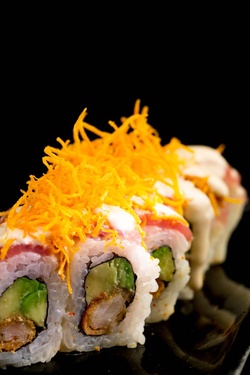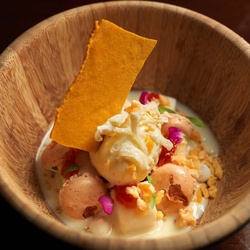There are many great masters of Peruvian cuisine: Teresa Izquierdo, Javier Wong, Adolfo Perret, Gloria Hinostroza, Blanca Chávez and Héctor Solís are some names, among which there are two of Japanese origin, which cannot be missed: Humberto Sato and Toshiro Konishi . With more than 50 years dedicated to this profession, they are part of the Japanese influence that has gained new strength in recent years with young chefs who have taken it upon themselves to preserve and renew their legacy.
The offering of Nikkei restaurants in Lima is a reflection of the importance of this aspect within Peruvian cuisine and identity. Hanzo, Osaka, Edo, Wasabi, Naruto, Ebisu are names that already sound familiar when choosing a Nikkei restaurant, where the techniques of Japanese cuisine have been assimilated by itamaes who incorporate typical Peruvian ingredients and preparations in their preparations.
If maki with avocado and Philadelphia cheese was born in California in the sixties, in Lima the acebichada sauce, slightly acidic, or the passion fruit sauce, sweet and sour, appeared to cover the rolls; and on the sashimi menus, tiradito was added, fish cooked in lemon and served with chili. Many of these innovations have their origin in the Matsuei restaurant, where various talents of Peruvian-Japanese cuisine emerged, such as Hajime Kasuga, Norio Takeda and Javier Matsufuji.
Currently, Peruvian Nikkei cuisine is in the hands of young people like Roger Arakaki, Mitsuharu Tsumura, Yaquir Sato, Juan Carlos Tanaka and Diego Oka, who from different fronts, in Peru and abroad, continue this story of flavors and knowledge. which has achieved renown through international fairs and awards to restaurants that are opening a new chapter to the recent boom in Peruvian gastronomy.
Signature Nikkei cuisine
Mitsuharu Tsumura is one of the youngest Nikkei chefs in Peru. He is 33 years old. His family comes from Osaka but he was born in Lima. He studied Culinary Arts and Food and Beverage Administration at Johnson & Wales University, in Rhode Island, United States, and then worked in different restaurants in Japan until he returned to Peru to work at the Sheraton hotel. But he wanted to be a cook.
In 2009 he created the Maido restaurant, where he pays tribute to both culinary traditions with surprising talent. “There is something that attracts attention in Mitsuharu Tsumura's kitchen. "Perhaps it is the mixture of a cuisine capable of contemplating everything," wrote the critic Ignacio Medina to present it at the Madrid Fusión fair, moved by a steamed bread roll, a pejesapo chicharrón or the poor sushi (entrant and egg of fried quail) that he has created at his premises.
His cult of the regional cuisines of Peru and his “transgressive filter of oriental forms” have been highlighted by Medina who has said of 'Micha', as he is affectionately called: “I have never seen another chef evolve so quickly. His open-mindedness led him to create a new, truly different cuisine. It was no longer the Japanese or their children adapting their cuisine to the conditions of a strange pantry. With Mitsuharu came the total symbiosis between the past and the future, Japanese and Peruvian, tradition and modernity.”
Culinary promotion
Mitsuharu Tsumura was at the last edition of Madrid Fusión in 2015 with his colleagues from 'La Pandilla Leche de Tigre' (Gastón Acurio, Héctor Solís, Virgilio Martínez and Rafael Piqueras), with whom he has been spreading Peruvian gastronomy around the world, through a simple proposal (leche de tigre, ceviche and pisco sour), but which has proven to be representative of all the creative, cultural and natural diversity of Peru.
His tour has included cities such as Chicago, Buenos Aires, Bogotá, Sao Paulo, Paris, Mexico City, Miami, Madrid and London (and soon to more countries in Europe and Asia). But the work of promoting Peruvian cuisine does not begin there for 'Micha'. In 2013 he published, together with the journalist Josefina Barrón, the book “Nikkei es Perú”, which narrates the meeting of Peruvian and Japanese culinary art to create a new cuisine.
There the history of Nikkei cuisine in Peru stands out, from Humberto Sato to Tomás Matsufuji, passing through the emblematic products (from the sea and the countryside) of this new culture that emerged from immigration, with the pioneers of restaurants such as La Buena Muerte, El Chinito and Huanchaco, from which Mitsuharu Tsumura's cuisine has been nourished, who, at the end of the book, leaves Maido's recipes such as loche squash tofu, rice nigiri with duck and custard apple sorbet, aguaymanto yolk and cocoa nest.
New challenges
In 2013, 'Micha' started a television program called “Perú, Cocina Nikkei, Chifa y Criolla” on the renowned El Gourmet channel, which is broadcast on cable. A year later, on the same signal, his program “Sentimiento Peruano” was broadcast, where he presented some of the classic Peruvian dishes. Now he has embarked on another project: the Nikkei Gastronomic Association (together with Octavio Otani, Humberto Sato, Toshiro Konishi, Hajime Kasuga, Rafael Matsufuji, Iván Matsufuji and Roger Arakaki), an initiative that brings together Nikkei itamaes, chefs and businessmen with the aim to position Japanese Peruvian cuisine in the world.
Likewise, other young Nikkei chefs have taken Peruvian cuisine in new directions. Juan Carlos Tanaka has been key to giving ramen an increasingly prominent space in Lima with Tokio Ramen, a small but high-turnover establishment, dedicated especially to this soup and its variants. Tomás Matsufuji himself, with his saltado bar at Al Toke Pez, opened a new possibility of Nikkei restaurants that have resonated, even among Peruvians without Japanese ancestry.

At the beginning of 2014, chef Guido Gallia, from the D'Gallia Cooking School, opened the Sukha Asian Cuisine restaurant, serving Asian cuisine (Japanese, Thai, Korean) in an elegant format, and at the end of the same year chef Christian Bravo opened Woking Noodle Bar, a bar with oriental dishes (stir-fry, rice and noodles) inside a shopping center. That same year, Sansushito became the first sushi bar within a market in the popular Surquillo district and is now preparing to open its first location abroad, in Miami, United States.
Nikkei cuisine seems to have no limits and borders, as Luis Arévalo, a Peruvian who opened the Kena restaurant in Madrid, after passing through the successful Nikkei 225, has already demonstrated; or Ciro Watanabe, at the head of Osaka in Chile, which last year ranked 30th in the Latin America's 50 Best Restaurants ranking (Maido was ranked 11th). Even the Nikkei restaurant Pakta, by Albert Adrià, with the Peruvian chef Jorge Muñoz, has achieved a Michelin star. It is in the hands of the new generations of chefs to know how far this constantly evolving cuisine can go.
© 2015 Javier García Wong-Kit








